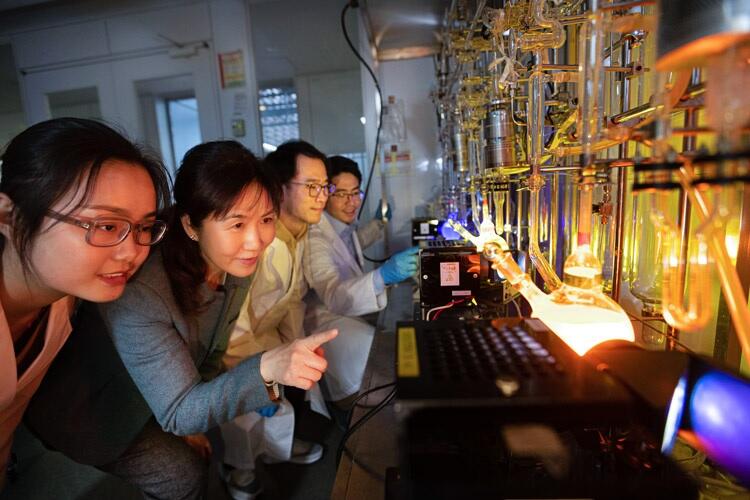
In this installment of the special feature "Researchers from across the sea," we introduce Dr. Jinhua Ye, a top researcher at the International Center for Materials Nanoarchitectonics of the National Institute for Materials Science (NIMS), who pursues the various potential cutting‐edge uses of photocatalysis as leader of the Photocatalytic Materials Group. She came to Japan from China, after the Cultural Revolution, during the bubble economy of the late Showa period, and continued her career as a researcher throughout the Heisei and Reiwa periods. Fascinated by the wonders of the world since childhood, she continues to investigate these wonders using a flexible approach, by focusing on the differences in values and systems between her two countries.
Getting advised "You are definitely suited for the sciences" when looking for a career path
Ye's hometown is Lishui, Zhejiang Province, China. She was very fond of science fiction as a young girl. Although China was in the midst of the Cultural Revolution when she was a girl, "There were works by Chinese science fiction writers, and I could read foreign works that had nothing to do with politics, and I also liked Greek mythology, especially the strange stories," she says.
She chose science as her career path without hesitation because she was good at mathematics and physics. Since modern China has frequently changed its political system, her parents welcomed her choice to major in science, a field that was resilient to systemic change. She says, "In China, there is no preconceived notion that a woman should study the humanities because she is a woman. Even my high school teacher recommended that I should definitely study science."
At the young age of 16, she entered the prestigious Zhejiang University in Hangzhou. While she was in school, the Cultural Revolution came to an end, and the Chinese government made a major shift toward reform and open‐door policy. Then, in 1984, at the age of 21, after graduating from college, she applied for a government‐sponsored scholarship. She passed the selection examination and made the choice to come to Japan.
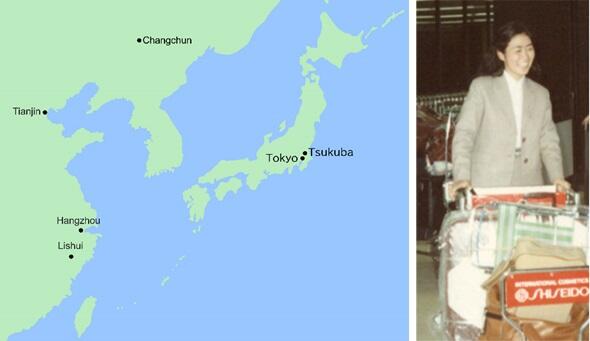
(photo provided by Ye)
Raising children while working is the norm
Ye came to Japan on a chartered aircraft of the Chinese government and entered graduate school at the University of Tokyo. At a time when foreign students from China were still rare, she was treated with great kindness by her academic advisors. She recalls fondly, "It was all so new and so much fun."
She completed her PhD in 1990. Initially, she had planned to return to China to engage in research, but when the Tiananmen Square protests broke out the year before, she decided to remain in Japan to study the situation some more. After working at Osaka University for two years, she became a special researcher at JST's predecessor, the Research Development Corporation of Japan, and then continued her research at the National Research Institute for Metals (Tsukuba City, Ibaraki Prefecture), the predecessor of NIMS.
Two years after moving to NIMS, she had a baby. At that time, there were very few female researchers in Japan, and there was no system in place for childcare leave or other leave. It was difficult to balance research and childcare, but she never thought about interrupting her work, partly because she grew up in China, where raising children while working is the norm. She was merely trying to find a way to overcome the difficulties. "I looked for a daycare center within walking distance from NIMS and tried to live near one. But when I was on a business trip, there was nothing I could do, so I asked the director to take care of my child," she recalls.

(photo provided by Ye)
Nearly 30 years have passed since then, and the number of researchers who give birth and raise children has increased, and the environment has improved considerably. Ye says, "At NIMS, we have a system in place whereby a replacement is hired during childcare leave, and research is carried out according to a pre‐designed plan." This is a system that kills two birds with one stone; not only does it allow researchers who are raising children to take time off without worry, but it also enhances the careers of the researchers who take their place.
Taking on the challenge of photocatalysts that can produce hydrogen directly from water
Ye, who had been studying superconductivity, began researching photocatalysis in 1997. It all started when a junior member of her laboratory at the University of Tokyo was transferred to the National Institute of Advanced Industrial Science and Technology (AIST), which is located in the neighborhood of NIMS.
"Photocatalyst" is a generic term for a substance that promotes chemical reactions as a catalyst when irradiated by light, and the technology for its practical application has progressed rapidly in Japan since the 1970s. Akira Fujishima, Professor Emeritus of Tokyo University of Science, and Kazuhito Hashimoto, President of the JST, are among those who have made significant contributions. Currently, the most common use is as a paint to remove bacteria and toxic substances, but various other uses are being explored.
What appealed to Ye in particular was the ability to create hydrogen directly from water. Since that time, researchers have recognized the importance of hydrogen energy, and photocatalytic technology has attracted attention as a means to achieve this goal. However, no one knew what kind of photocatalyst could be developed to obtain hydrogen efficiently. Hence, she decided to take on this challenge.
Enabling highly efficient conversion of methane to ethane
Ye's research went well and produced one result after another. "I was selected for JST's 'PRESTO' program and for a collaboration project between industry, academia, and the government of the Ministry of Education, Culture, Sports, Science and Technology (MEXT), and so my research accelerated rapidly. Although I was a young foreigner, my research results were evaluated fairly, and I received large research grants. I wonder whether I would have obtained the same results if I had been in another country," she recalled.
She is regarded as one of the world's top researchers in the development of new photocatalytic materials for a more efficient use of solar energy, their transformation into new value‐added materials, and their field of applications. Her groundbreaking achievements include the discovery of a photocatalyst that efficiently decomposes organic pollutants and research results that have enabled a highly efficient transformation of methane to ethane, a greenhouse gas that is more potent than carbon dioxide (CO2).
She is also working on issues directly related to the future conservation of the global environment, such as the application of photocatalysis to the generation of renewable energy and the development of new materials for the transformation of sunlight into chemical energy.
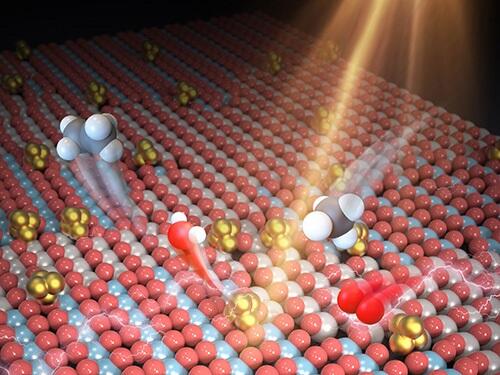
(photo provided by Ye)
Collaboration progresses with China, but with a headwind
NIMS collaborates with several universities in Japan, and in the case of Ye's lab, a doctoral student from Hokkaido University is staying in Tsukuba to conduct research. In addition, international collaborative research with Tianjin University in China has been underway since 2011, and university partnerships have begun to blossom. The project started when a researcher from Tianjin University who had been working at NIMS returned to China, and the "NIMS‐Tianjin University Joint Research Center" was established on the campus of Tianjin University, with funding and facilities provided by the University and with researchers dispatched from NIMS, and Dr. Ye was appointed as the center director.
In this case, research was conducted with the aim of jointly developing functional materials that contribute to solving environmental and energy problems, and the original contract, which was for five years, was renewed in 2016, but "since about 2017, there has been a bit of a headwind when cooperating with China," she says. The project was then terminated when the contract expired in 2021.
This fast‐changing Japan‐China relationship has always been a source of worry for Ye. The relationship between the two countries can be a tailwind or a wall that stands in the way of research. "I understand both sides to a certain extent, so it can be frustrating," she says.
Japan's fair evaluation is an opportunity, but excessive egalitarianism can be concerning
When Ye arrived in Japan, Japan was in the midst of an economic boom and was one of the world's leading countries in science and technology. In the decades since then, however, China has developed dramatically, and in terms of research capabilities, the two countries have reversed places in most fields. Photocatalysis, known as a Japanese‐bred technology, is no exception.
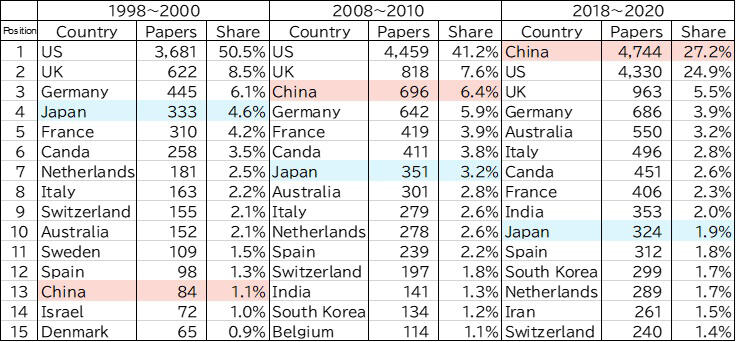
(compiled by Science Portal editorial staff from NISTEP's "Science and Technology Indicators 2022")
Since around 2008, China has surpassed Japan in the number of papers cited in most fields. One reason for this, says Ye, is that "the budgets that China receives from the government are off the charts." She also notes that differences in national character may also affect the difference in research capabilities. "China, like the U.S., has a strong performance‐based system, whereby those who work hard get the benefit of their hard work. Conversely, it is not bad that Japan is good at judging results fairly, but in terms of evaluating them and nurturing talented researchers, egalitarianism may be going too far."
In other words, in Japan, research results are evaluated fairly, and young researchers and those from other countries have equal opportunities if they are capable. But on the flip side, there is a concern that excessive egalitarianism may be robbing young researchers of motivation.
So what can be done to break out of this status quo? She says, "I would like to see young researchers actively exposed to worldwide cutting‐edge research, rather than remaining stuck in Japan. Doing so could be a catalyst for diverse ideas and ways of thinking to enter Japan."
"I would like to eventually build a device that can produce hydrogen and methanol simply by exposing it to sunlight outdoors," she says, still keeping alive and well her passion for exploring the wonders of the world. Hoping for a bright future for young researchers, she will continue her research diligently.
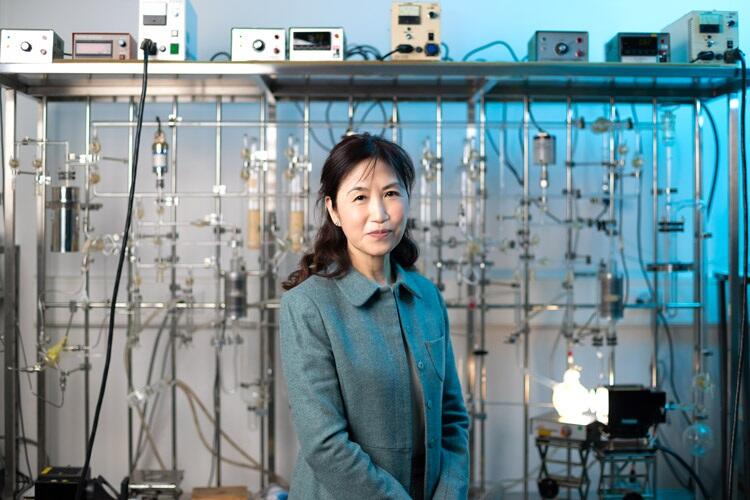
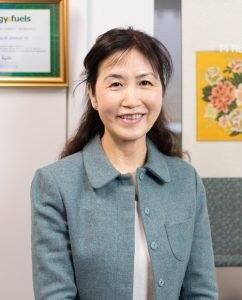
Profile
YE Jinhua
Principal Investigator, Photocatalytic Materials Group Leader, International Center for Materials Nanoarchitectonics, National Institute for Materials Science (NIMS)
Graduated from Zhejiang University, China. Obtained a Ph.D. in Science from the University of Tokyo. After working as Research Associate at Osaka University, Special Researcher at the National Institute for Materials Science, and Principal Investigator at the Eco‐materials Research Center, NIMS, she has been in her current position since 2016. She is also a professor in the Department of Functional Materials Chemistry, University of Hokkaido‐NIMS Joint Graduate School.
Original article was provided by the Science Portal and has been translated by Science Japan.




